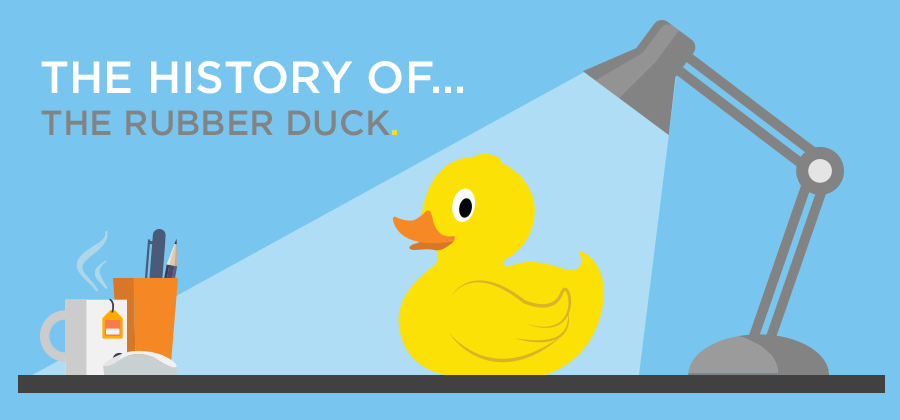

THE HISTORY OF THE RUBBER DUCK.
Reading TimeYou’ll see from our website, social media, and if you come to visit our offices, that the B1 employees are in fact outnumbered by hundreds of yellow feathered critters. So where and when did this transition from foul to friend happen? It was more a case of the duck coming to us, in the form of a degree show business card. Ever since then, rubber ducks have simply swum in the B1 veins.
The history of the rubber duck is quite an interesting one, going through multiple transformations during the 1800s, 1900s and right up to the present day. Some people argue (yes, really, there are debates) that the first rubber duck was a replica of Donald Duck, produced by Disney in the 1930s, with the help of manufacturers the Seiberling brothers. The brothers later started up the Goodyear Tyre & Rubber Company that is still famous today, but in fact, to look at the full history of the rubber duck, we must back track around one hundred years to Mr Goodyear himself…
Charles Goodyear was born in the year 1800 in New Haven, Connecticut. He spent his early career as a hardware merchant and at the age of 34, entered the New York store Roxbury India Rubber Company, trying to sell them his wares. Sadly for Goodyear they weren’t interested, as the company itself was in a bit of a tight financial squeeze, the weather having ruined thousands of dollars worth of stock. But this trip was not completely useless, as it did spark Goodyear’s interest in the idea of “gum elastic”, and a rubber that could withstand seasonal weather conditions without melting in the summer or hardening in the winter. Soon after this occasion, he found himself with a lot of time on his hands, being jailed for debt, and in his cell started to experiment with raw rubber, rolling it out day after day with a pin.
1839: A GOOD YEAR FOR RUBBER.
Over the next few years, once out of prison, Goodyear worked on a concoction, adding minerals to the rubber to stop the stickiness. In 1839 the perfect solution was found, when his gum and sulphur mix was accidentally dropped into a stove and didn’t melt. This process of making rubber malleable became known as vulcanisation. Sadly Goodyear died in 1860, but his findings were an inspiration to many future manufacturers, hence why the Seiberling brothers named their company in his honour.
In the late 1800s, records started to appear for the first productions of rubber ornaments. In most cases these were chew toys, made from a hard, solid version of the material and therefore these did not float. The United States Patent Office records give us a good understanding of how the traditional rubber duck came about.

In 1886, a patent was drawn up for a rubber duck which wasn’t a toy, but instead described as a “Rubber Decoy Duck”, probably used in hunting practices. Invented by George H Nye, this duck was made of both hollow rubber and wood, and was described as an improvement on ducks used previously that were made entirely of wood. This caused problems as the fragile heads constantly broke.
A patent was approved in 1904 for a rubber toy, this time of a human figure, made of hollow rubber and containing a “squeaker” or “bird-tone appliance”, designed to make a noise as a result of the “compression and the re-expansion of the said hollow elastic article”. There were more developments to this kind of toy before 1928, when a patent was approved for a toy duck. This was a “weeble” toy, meaning that it had a counter-weight so that when knocked over, it would instantly return to an upstanding position.
MAKING A SPLASH.
Have you ever wondered why the rubber duck is particularly associated with bath time? In 1933 and 1937 respectively, two “aquatic toys” shaped like ducks were produced. The first toy attached to the tap nozzle, and sprayed water out of small holes in its back like a sprinkler, and then four years later, a duck was developed that had a propeller attached to the back.
After the second World War, Russian-American sculptor Peter Ganine, known more famously for his chess sets, submitted a patent for a duck ornament solely for playing purposes. Despite the lack of functions and attachments, this duck design was hugely popular, and a whopping 50 million were sold. The Ganine duck had a smiling beak and lazy looking eyes, and the Allen & Shaw patent from the next year had a small beak but big bulging eyes. The most recognisable rubber duck of today is a hybrid of these two historical designs.
The rubber duck has no gender, no cultural ties, no age and is therefore accessible to everyone, without causing offense. With water play proven to aid muscle development, coordination and cognitive learning, it can inspire the young, as well as providing fun for us adults too.
A DARK, DUCK SECRET…
But behind its bright yellow plumage and orange beak, the innocent, modern day rubber duck in fact holds a dark, dark secret; it isn’t actually made of rubber. For decades now ducks have been made from vinyl, so are technically plastic ducks (doesn’t quite have the same ring to it, does it?). But don’t hold it against them, for whether they’re wood, rubber or plastic, the toy duck has brought joy to both young and old for nearly ninety years. It’s hard to avoid the rubber duck, as it is now a popular symbol worldwide. Ducks are reproduced in different colours, patterns, costumes, and even to resemble famous faces. Collecting ducks can become somewhat of an addiction, or perhaps an obligation, and in the B1 office alone we have 176. We’ve got to work hard if we’re going to beat the Guinness World Record holder Charlotte Lee, however, as her twenty year collection is now up to 5,631…
The rubber duck has many accolades of its own. In 1970 one duckie became a billboard star, reaching number 16 in the charts with the help of Sesame Street’s Ernie and his bath time antics. Ducks made news headlines in 1992 after 29,000 ducks fell off a cargo ship in the Pacific, some finally making it back to shore years after in locations across the globe. It was also reported in 2001 by a visiting workman that in Buckingham Palace, the Queen has her own rubber duck by her bath side, adorned with an inflatable crown (this story sparked an 80% sales increase of ducks in the UK…).

Rubber duck races, or derby duck races as they’re also known, are held annually across the world to raise money for charity. Disappointingly, this doesn’t involve little rubber ducks racing around a track in sweat bands and Lycra; instead, participants sponsor one of thousands of ducks before they are placed into a waterway, and the first to cross the line wins a prize. And speaking of ducks in water, remember Florentijn Hofman’s 105 feet tall duck sculptures that were displayed in several countries in 2013 and 2014?
Chart success, near death experiences, brushes with royalty AND charity fundraising… These ducks are giving even Bob Geldof a run for his money. It’s no wonder, therefore, that in 2013, the rubber duck was finally inducted into the National Toy Hall of Fame.
RUBBER DUCKIE, YOU’RE SO FINE.
And why not? Unlike so many of today’s icons, the rubber duck can appeal to all. It has no gender, no cultural ties, no age and is therefore accessible to everyone, without causing offense. With water play proven to aid muscle development, coordination and cognitive learning, the little rubber duck can inspire the young, as well as providing fun for us adults too. So, next time you look at a little duckie friend, remember Ernie’s words: “Rubber duckie, you’re the one!”
